
Unlocking Natural Fluency: The Power of Common Expressions Worksheets
In the intricate tapestry of language, beyond grammar rules and vocabulary lists, lies a vibrant layer of meaning that often eludes learners: common expressions. These idiomatic phrases, phrasal verbs, proverbs, and colloquialisms are the very heartbeat of native speech, coloring conversations with nuance, humor, and cultural insight. Mastering them is not merely about expanding vocabulary; it’s about bridging the gap between academic proficiency and genuine, natural fluency. This is where Common Expressions Worksheets emerge as an indispensable tool, offering a structured, practical pathway to understanding and effectively using these linguistic gems.
The journey to language mastery is often depicted as a linear progression from basic vocabulary and grammar to complex sentence structures. However, true fluency demands an intuitive grasp of how native speakers actually communicate. Imagine encountering phrases like "break a leg," "kick the bucket," or "raining cats and dogs." A literal translation would leave any learner utterly confused, highlighting the critical need to understand expressions within their cultural and contextual frameworks. This is precisely the challenge that Common Expressions Worksheets are designed to address, providing learners with the targeted practice necessary to decipher and deploy these often-tricky phrases with confidence.
Why Common Expressions Are Indispensable
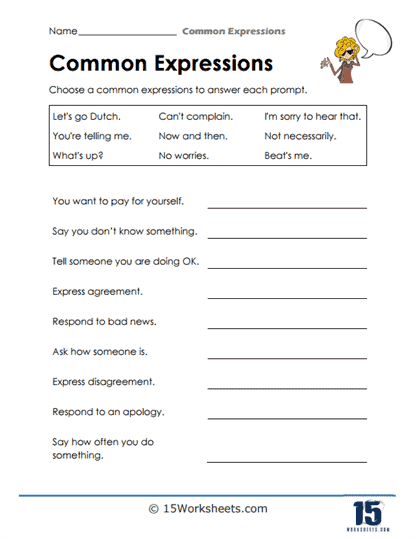
Common expressions are far more than linguistic embellishments; they are fundamental to authentic communication. Without an understanding of these phrases, a language learner might find themselves perpetually on the periphery of natural conversations, missing subtle jokes, failing to grasp implied meanings, or sounding unnaturally formal and stiff. Here’s why they are so crucial:
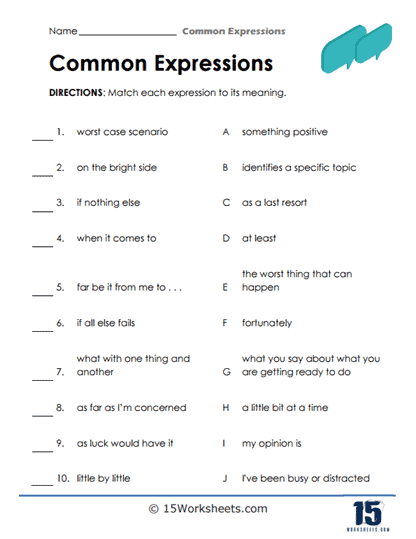
- Naturalness and Fluency: Using common expressions makes your speech sound more native and less like a textbook. It adds a layer of authenticity that signals a deeper understanding of the language.
- Enhanced Comprehension: Native speakers use these expressions constantly in everyday conversations, movies, TV shows, and literature. Understanding them is paramount to comprehending the vast majority of spoken and written English.
- Cultural Insight: Many expressions are deeply rooted in a culture’s history, values, and worldview. Learning them offers a fascinating window into the target culture, enriching the overall language learning experience.
- Efficiency in Communication: Expressions often convey complex ideas or emotions concisely. "Bite the bullet" encapsulates the idea of enduring a difficult situation, far more efficiently than a lengthy explanation.
- Avoiding Misunderstandings: Literal translation of idioms can lead to hilarious, yet sometimes awkward, misunderstandings. Knowing the true meaning prevents these pitfalls.
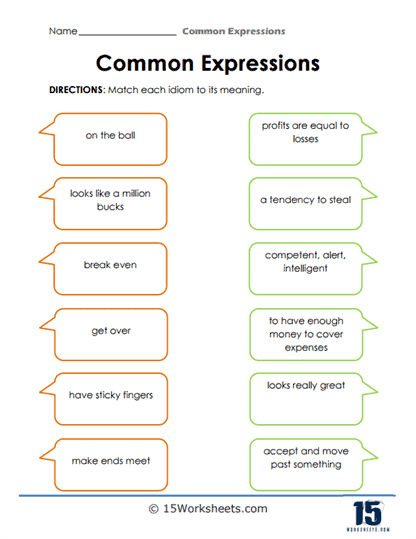
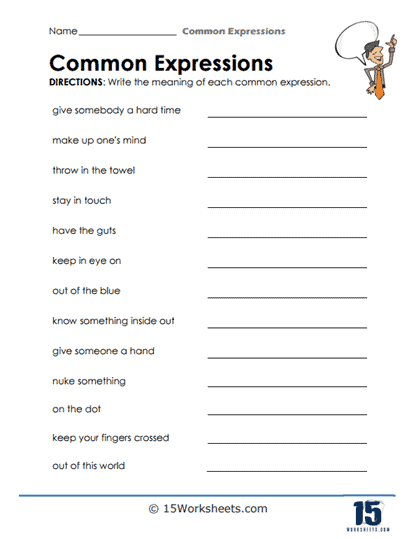
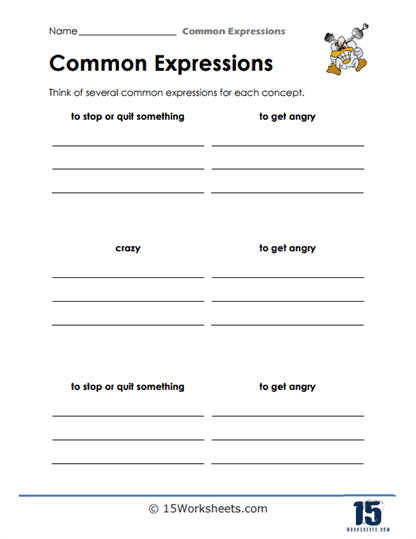
The Role and Design of Common Expressions Worksheets
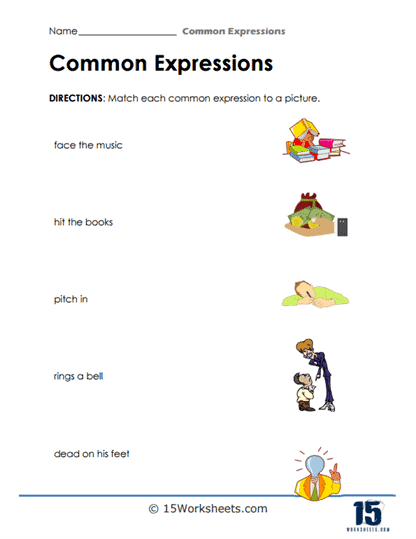
Common Expressions Worksheets are pedagogical tools specifically designed to facilitate the acquisition of these often-elusive linguistic units. Unlike general vocabulary exercises, these worksheets focus on phrases where the meaning cannot be deduced from the individual words alone. They present expressions in context, guide learners through various practice types, and reinforce understanding through repetition.
A well-designed common expressions worksheet typically incorporates several key elements:
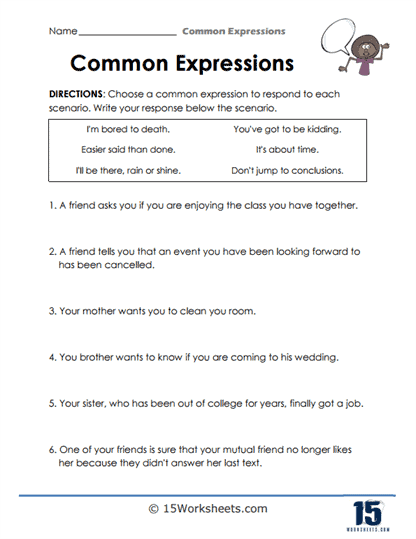
- Contextualization: Expressions are rarely learned in isolation. Worksheets provide sentences, short dialogues, or paragraphs where the expression naturally fits, helping learners infer meaning and understand appropriate usage.
- Clear Definitions: While context is key, a clear, concise definition of the expression’s meaning is essential, often accompanied by synonyms or explanations of nuances.
- Varied Exercise Types: To cater to different learning styles and reinforce understanding, worksheets employ a range of exercise formats.
- Answer Keys: For self-study or classroom use, a comprehensive answer key allows learners to check their understanding and learn from their mistakes.
- Progression: Effective worksheets often follow a logical progression, starting with simpler, more common expressions and gradually introducing more complex or less frequent ones. Some might group expressions by theme (e.g., emotions, business, daily life) or by grammatical structure (e.g., phrasal verbs with "up").

Types of Exercises Found in Common Expressions Worksheets
The versatility of Common Expressions Worksheets stems from the diverse array of exercises they offer. These activities move beyond mere memorization, encouraging active recall, contextual application, and even creative use of the expressions:
- Matching Exercises: Learners match an expression with its definition, a synonym, or a picture that represents its meaning. This is excellent for initial recognition and understanding.
- Fill-in-the-Blanks: Sentences are provided with a blank space where the appropriate expression needs to be inserted. This forces learners to consider context and correct usage.
- Example: "After working all night, I was so tired I could __." (drop dead / hit the hay / pull someone’s leg)
- Multiple Choice: Similar to fill-in-the-blanks, but with a selection of possible expressions, often including plausible but incorrect distractors.
- Sentence Completion/Creation: Learners are given an expression and asked to use it correctly in a new sentence of their own. This encourages active production.
- Dialogue Completion/Creation: Short conversations are provided where expressions need to be added or created, simulating real-life usage. This is particularly effective for understanding the social context of expressions.
- Error Correction: Learners identify and correct misused expressions in given sentences. This sharpens their eye for subtle errors and reinforces correct usage.
- True or False Statements: Statements containing expressions are presented, and learners decide if they are used correctly or if the meaning conveyed is accurate.
- Story Writing Prompts: Learners are given a list of expressions and asked to weave them into a short story or paragraph. This is a higher-level activity that promotes creative application.
- Discussion Questions: Worksheets can include questions that prompt learners to use the expressions in their answers, fostering communicative practice.
- Categorization: Learners group expressions by theme, emotion, or type (e.g., idioms, phrasal verbs, proverbs), which helps organize their understanding.
Benefits of Utilizing Common Expressions Worksheets
The strategic integration of Common Expressions Worksheets into a language learning curriculum or self-study routine yields numerous benefits:
- Systematic Learning: Worksheets break down the daunting task of learning countless expressions into manageable, structured units. This systematic approach is more effective than random exposure.
- Active Recall and Retention: The varied exercises encourage active recall rather than passive reading, significantly improving retention rates.
- Enhanced Listening Comprehension: By repeatedly encountering expressions in written form and understanding their meanings, learners are better equipped to recognize and interpret them in spoken English.
- Improved Speaking Fluency and Naturalness: Practicing expressions in context and creating sentences with them empowers learners to integrate them into their own speech, leading to more natural and confident communication.
- Vocabulary Expansion Beyond Words: Learners gain not just new expressions but also a deeper understanding of the nuances of language, expanding their communicative repertoire significantly.
- Self-Paced Learning: For independent learners, worksheets offer a flexible, self-paced method to master expressions, allowing them to focus on areas where they need the most practice.
- Teacher-Friendly Resource: For educators, these worksheets are invaluable for lesson planning, providing ready-made activities that can be adapted for individual, pair, or group work.
Maximizing the Impact: Strategies for Using Common Expressions Worksheets
While Common Expressions Worksheets are powerful tools, their effectiveness is greatly amplified when used strategically:
- Pre-Teach and Contextualize: Before diving into exercises, introduce the expressions. Explain their literal origins (if helpful), discuss their meanings, and provide multiple examples in different contexts. Visual aids or real-life anecdotes can make them more memorable.
- Integrate with Authentic Materials: Supplement worksheet practice with exposure to expressions in real-world contexts. Watch clips from movies or TV shows, listen to podcasts, or read articles where the expressions are used naturally. Discuss how they are used in these authentic materials.
- Encourage Active Production: Don’t stop at understanding. Prompt learners to use the expressions in their own speaking and writing. Role-playing, debates, or simply recounting daily events using new expressions can solidify learning.
- Spaced Repetition: Revisit expressions periodically. Instead of just completing a worksheet once and moving on, integrate review sessions. Flashcards, quizzes, or simply trying to use a few expressions from previous weeks in new conversations can be highly effective.
- Personalize Learning: Encourage learners to connect expressions to their own experiences. If an expression is "to bite off more than you can chew," ask them if they’ve ever done that and to describe the situation using the expression.
- Focus on Commonality: Prioritize learning the most frequently used expressions first. While it’s fun to learn quirky idioms, focusing on high-frequency phrases will yield more immediate communicative benefits.
- Don’t Fear Mistakes: Language learning is iterative. Encourage learners to experiment with expressions and view mistakes as learning opportunities. Correct gently and provide constructive feedback.
Conclusion
The journey to true language fluency is multifaceted, requiring a blend of grammatical precision, extensive vocabulary, and, crucially, an intuitive grasp of common expressions. These vibrant linguistic units are the key to unlocking natural-sounding communication, enhancing comprehension, and fostering a deeper cultural understanding. Common Expressions Worksheets stand as a robust and versatile resource in this endeavor, providing the structured practice and contextual exposure necessary to transform confusing phrases into powerful tools of communication. By embracing these worksheets and integrating them with active, real-world application, learners can confidently navigate the nuances of English, moving beyond rote memorization to truly speak, understand, and appreciate the richness of the language. They are not just exercises; they are stepping stones to authentic linguistic mastery.

